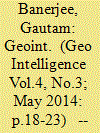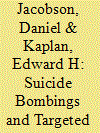|
|
|
Sort Order |
|
|
|
Items / Page
|
|
|
|
|
|
|
| Srl | Item |
| 1 |
ID:
130879


|
|
|
|
|
| Publication |
2014.
|
| Summary/Abstract |
Combat, by its very definition, is an event extra-ordinarily excruciating. It is an ultimate condition that is distinguishable by its phenomenal characteristics which demand, among other undertakings, absolute perfection in marshalling the diverse elements of combat that constitute a military force, for example, troops, firepower, mobility and intelligence. Thus down the ages, 'Great Captains' of war have articulated their strategic intellect to secure victory, irrespective of the bulk of forces, by the best orchestration of the resources under their command. In modern times, developments in 'Information Warfare' have raised the bar of such Terrain intelligence has always been important for winning a battle. In this aricle, the writer advocates establishing a repository of battle-space geographic information called Military Geospatial Intelligence System (MGIS) orchestration to such a high level that it becomes possible to exploit to the hilt the individual capabilities of each element of the military machine. More importantly, it is possible now to seamlessly integrate all such diverse force-elements into one whole system of war-fighting. Military intelligence - terrestrial, strategic and tactical - has always been the most decisive factor in application of combat power as well as an enabling tool for the aforementioned 'best' orchestration of military resources. Within its overall ambit, terrain intelligence - geospatial intelligence in the wider sense as we understand today - has been the pivot of strategic, operational and tactical decision making. In the contemporary period of technological explosion, that pivot has assumed unlimited scope for articulation. At the crosshairs of ever-adversarial forces across terrains of unique descriptions, institution of an efficient mechanism for harnessing the properties of geospatial intelligence - MGIS - must, therefore, be a top priority for India. However, to be really effective, that endeavour has to be tailored to Indian conditions and backed up with indigenous competences; the scope and coverage of GIS as propounded by the lead militaries of the world, USA, China, NATO and Russia, is neither accessible nor sustainable and may not even be necessary in the context of India's technical-industrial-fiscal capacity, and inter alia, her military objectives.
|
|
|
|
|
|
|
|
|
|
|
|
|
|
|
|
| 2 |
ID:
079527


|
|
|
|
|
| Publication |
2007.
|
| Summary/Abstract |
This article develops sequential game models for key operational terrorist (how often to attack) and government (how often to execute targeted killings) decisions taken during a (counter-) terror campaign such as the second intifada. Key results include the following: The government initiates targeted killings when the marginal number of Israeli civilian lives saved from prevented terror attacks exceeds the marginal number of Palestinian civilian lives lost in such ``hits''; targeted killings are not employed if they are either ineffective or extremely effective at thwarting terror (since terrorists will not induce their use); even after accounting for downstream terror attacks motivated by prior targeted killings, a civilian casualty-minimizing government can optimally order targeted killings over time; and low-level cycles of violence can occur when the government is more patient than the terrorists, but higher, stable levels of violence result when the terrorists are the more patient players in the game
|
|
|
|
|
|
|
|
|
|
|
|
|
|
|
|
|
|
|
|
|